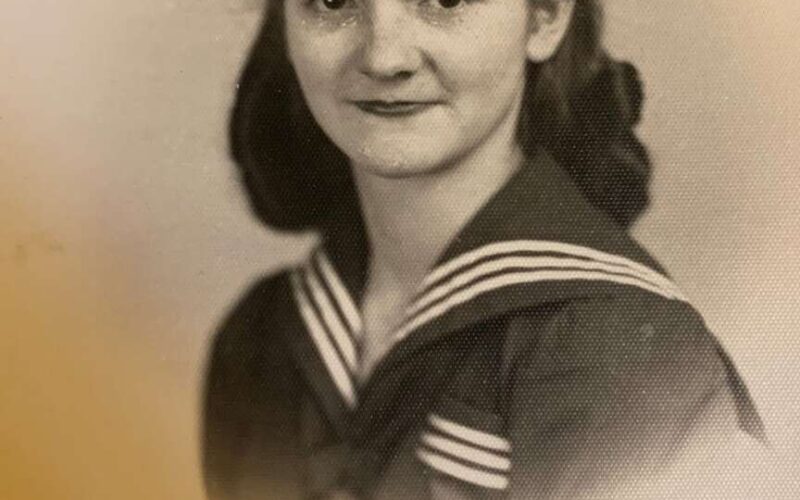April Wallace
awallace@nwaonline.com
As a child, it’s easy to accept the people, surroundings and circumstances around us as just a given. But the older that Dinah Jordan got, the more she realized that her aunt and uncle had a truly remarkable story. The two of them, one who was from Arkansas, were diagnosed with and changed by polio. Then they met, fell in love and lived a life of independence, largely only relying on each other.
They are now the subject of “Defying Disability: One Couple’s Journey of Fierce Love and Unwavering Faith.” Dinah Jordan spent years considering their intertwined stories before she decided to write her first book, a biography which focuses on both of their lives and how it changed when they came together.
To Dinah, they were always aunt Darlene and uncle Bert. They lived in Dallas when she was young and growing up in Illinois, but she saw them once or twice a year when the family would travel to see them or go on vacations.
“When you’re young, you don’t think any different,” Jordan said by Zoom. “They’re in wheelchairs, but as I grew up and became older, I realized how special their story was, to have two (disabled) people in a marriage care for each other and two children.”
Darlene Fox Streat grew up in DeValls Bluff, Ark., where she was married at age 14. By 15, she gave birth to her daughter Janis. Her husband was in the military and while he was in Europe during World War II, Darlene contracted polio at age 17 and became paralyzed.
Once he was discharged, “he went through the motions of being married, but he wasn’t interested in having a disabled wife,” Jordan said.
Darlene stuck around in DeValls following the divorce, but she wanted to work. It was the 1940s, and a movie theatre was opening in the town. She wrote a letter to the owner, seeking employment. She was open about her disability, and didn’t specify what type of position she sought, only that she wanted to work there in some capacity.
“She found out she was accepted for the job when someone from the (theatre) staff came to measure her wheelchair,” Jordan said. They would hire her and make their doors accessible so she could work there as the cashier who worked at the front. “It showed a lot of courage on her part to say ‘Here I am.’”
Five years into her new gig, in 1952, Darlene was handed another opportunity she couldn’t pass up. Someone working in Arkansas government became aware of her case and offered her financial assistance to attend a rehabilitation facility in Oklahoma.
She would have to leave her daughter with her mom, Effie Jones Fox, to go reap the benefits of learning new, marketable skills and ways to gain independence that could give her a chance at a more typical life.
Once there, Darlene met Bert B. Cherry, who would quickly become the love of her life.
Bert describes meeting her in a passage of “Defying Disability,” which reads, “In May 1952, my world would start changing when the most beautiful girl came to the center from Arkansas. She had outstanding red hair and a beautiful smile. I could not keep my eyes off her.”
Sometimes Bert would summon himself to cross the room and ask her out for a date, but always talked himself out of it, thinking she just would have said no.
“He was smitten with her right away,” Jordan said. “He saw that red head and (beautiful) smile and fell in love. He didn’t think he was good enough for her.”
Bert’s chance came one day when Darlene was complaining about a task she had to do on the standing parallel bars. He bet her two movie tickets if she could get a “C” or better on it. Either way, they’d have a date.
Because both of them had similar disabilities, they could be more understanding. They knew more completely what each other had been through, could bypass judgment and more quickly get to a place of figuring out how to do this, live life with polio and do normal things.
Dinah has always been fascinated with the couple’s story, but considered many times whether she was close enough to them, whether she knew enough to write a book about their lives. She told her uncle Bert in 2001 that she wanted to talk to him about it, and eventually write their story. More than 10 years later, they began to correspond by email. She asked the questions, and even though he had use of only one hand, he replied.
Jordan asked them what life was like before polio, about their polio experience and how it affected them, as well as their faith. Polio affected them each differently. Darlene contracted it first, in 1945, and Bert in 1949. Even in that short span of time, “there were differences in how it was treated,” she said. As a result, Darlene had more paralysis than Bert did. He could walk with support.
“I remember watching him, he would use my aunt’s wheelchair as support,” Jordan said. And Darlene would navigate.
Thanks to the physical therapy she received at the rehab facility, she had incredible upper body strength. She could lift herself into the chair. When their son was a few weeks old, they bought a house, which had some customization such as lower shelving to accommodate their needs. But they were adamant that they didn’t want it to seem like a house for the disabled, Jordan said.
Once well into parenthood, could get their kids to school with the use of a car that had hand brakes and an occasional carpool with the neighbors.
“It’s inspiring to know how much they carved their own path of making things work,” Jordan said. Bert’s father was a preacher and not particularly excited about the prospect of two people with disabilities getting married. “He thought they would end up having to take care of them.”
After seeing them make it on their own, he admitted years later that they wound up being the best thing for each other and he was wrong to not have believed in them in the first place.
Dinah Jordan finally began actively writing Darlene and Bert’s story in May 2020, during the covid pandemic. Darlene had passed away only a couple of months before, and Bert had too, but the couple had written down a lot of their memories and shared it with their niece in preparation of her project.
Other family members pitched in and helped fill in any gaps in their narrative. For some events, that meant Dinah heard about the same moment from multiple perspectives. She had a working draft by the fall and once her parents and cousins read it they began to present her with feedback. Then Dinah’s coworkers pitched in to review it before she enlisted a publishing company, which published it in November 2021.
“I think (Darlene and Bert) are an inspiration,” Jordan said. That “things can be overcome if we put our mind to it and work together.”
——
FYI
“Defying Disability: One Couple’s Journey of Fierce Love and Unwavering Faith” is available for purchase in paperback through both Amazon and Barnes and Noble, in eBook through Kindle and Kindle Unlimited and in audiobook form through Audible, Amazon and iTunes.
For more information, visit StoriesbyDinah.com










